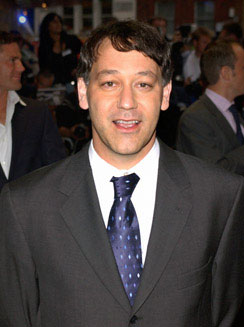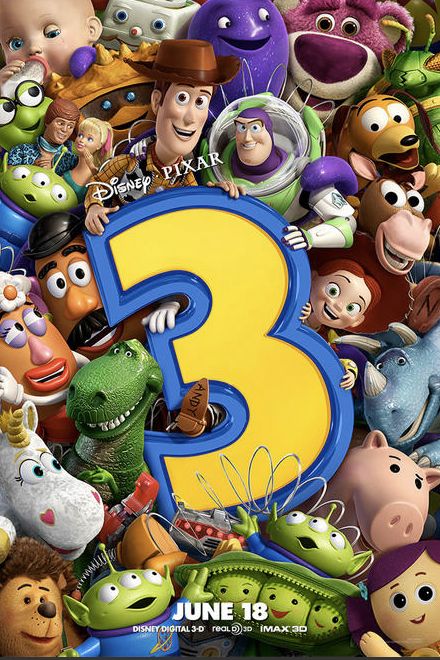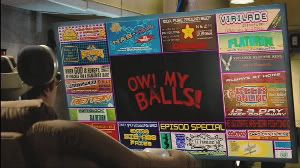What signifies a film as great? It's a rhetorical question easy enough to answer, but surprisingly complex to do so thoroughly. Obviously, the film must be well made. It also has to entertain and inspire people, move them emotionally, influence other filmmakers, make a mark on society, and above all else commit to the ages. Beyond that, the decisions are purely subjective.
For me, the benchmark for Great Film Lists is the American Film Institute's. Just the name seems to encapsulate cinematic excellence. Just say it aloud: American, Film, Institute. These are experts whose opinions I can trust.
In 1997, right when my film obsession began percolating, the AFI aired a three hour special on CBS, counting down their selection of the 100 greatest (American) films of all time. Partnered with professional filmies and clips from the prestigious winners, the countdown was just gravy for me.
In 2007, ten years later, AFI updated the list, wanting to see what difference ten years made on the cultural scale. Some classics were bumped, some new classics were added. With a film school education now at my disposal, it was fun seeing the format in an entirely new light. Since then, these AFI lists have ceased, with the implied exception of further updates to the Top 100 List repeating every ten years.
All in all, the project succeeded by portraying exactly what they claimed: Film is an ever-growing art form. Times change, tastes change, but the true greats are great forever.
As said before, the list will most likely be updated again in 2017. New films from the past decade will be included among the greats, and older classics will be seen in new lights. But in order to make room, some films will have to be bumped. It's not easy to predict which (if any) will get the axe.
Ten Films From AFI's 100 Years, 100 Movies List Most Likely To Be Bumped
10) Spartacus (1960)dir. Stanley Kubrick
The Reason: Great, Not Top 100 Great
The title "100 Greatest Movies" is a very selective list. This isn't just a list of great movies, it's the list of the greatest. Of all time. Each film is squaring off against each other; any flaw is magnified a thousand times. Spartacus is a great film. It's directed by one of the all-time greatest directors, it's epic in scale, majestic in execution and is the quintessential gladiator movie (suck it, Russell Crowe).
Unfortunately, when stacked up against the rest of the list, it's cracks start to show. Around the middle of the 198 minute runtime, it slows down and the intense sword-and-shield action is replaced by dialogue drama. It's artistic, but it's long, slow, and while those are not necessarily bad things, it's such a sudden shift in what we've been promised. Stick with Ben-Hur, and give Spartacus' slot to something else.
9) The Sixth Sense (1999)dir. M. Night Shyamalan
The Reason: Too Strong a Genre Film.
I'm not one of the people who jumped on the 'I Hate Shymalan' bandwagon. I think the man is still a strong director with a signature style, and still has the potential to resurrect his career (as long as he stops writing his own scripts). The Sixth Sense remains his seminal work. It's dark, chilling, suspenseful, eerie, and it's surprise ending is quite possibly the most famous in movie history. It is one of the greatest horror films of all time, no exceptions.
But, unfortunately, it excels so well at being a horror film, it does little else. The Sixth Sense draws inspiration from many films preceding it, but it has not directly inspired any films itself. The Sixth Sense is not a bad movie, but on the 100 Greatest Films list, genres are given a royal screw job. On a list majorly composed of dramas, a few genre films sneak in, but can only do so by completely and perfectly encapsulating their specific field. And maybe, for the moment, The Sixth Sense does just that with the horror genre. But that's it. On film as a whole, The Sixth Sense has done very little. Even on the AFI telecast, the only thing film experts had to talk about was the twist ending, and how it shocked America, and how the internet makes such a spoiler impossible in today's world (Because there was no internet in 1999, apparently).
Ten years from now, something else will fill the 'Reserved-For-Horror' slot. Maybe its a horror film from years gone by (Night of the Living Dead, Dracula), maybe its something more recent (Jurassic Park, The Shining), or even something which hasn't been made yet. The only thing I'm certain is the film which will replace The Sixth Sense will exemplify less the horror genre, and more of film as a whole.
8) Modern Times (1936)dir. Charles Chaplin
The Reason: The Department of Redundancy Department
Of the ten films on this list, this is the one I sincerely hope I'm wrong about. Modern Times is a terrific and hilarious film. It dissects 1930's society, shining a light on the guilty pleasures and ignored shames of urban life in a manner that freakishly remains applicable today. It's fun, it's insightful, and now that I've defended it, I hope I'm wrong about what I'm about to say in the next paragraphs.
Charlie Chaplin has three films on the AFI list: City Lights, The Gold Rush, and Modern Times. Each of these films features Chaplin as his trademark Little Tramp character, and each one is a great quality film. It's near impossible to pick the worst among the three. Unfortunately, the ranking system of the 100 Greatest Film list can, placing Modern Times below its brothers. It's not that Modern Times is worse, its simply because
something has to be last. Statistically, it's clear the voters prefer City Lights and Gold Rush slightly more.
Thus, when push comes to shove, three Chaplin films may seem like excess to the voters. One, he definitely deserves. Two, he certainly deserves. Hell, Chaplin deserves all three, but as more and more landmark films fight for a mere 100 slots, Chaplin's bountiful excess will be trimmed. Chaplin supporters will be forced to make cuts, and since Modern Times trails behind The Gold Rush and City Lights, it will eventually disappear. Modern Times is a great film, but Chaplin can only hold three positions for so long.
7) Platoon (1986)dir. Oliver Stone
The Reason: The Vietnam War Isn't So Great Anymore
As my brother pointed out while watching the AFI telecast, there are a lot of movies about the Vietnam War. I can understand it; the Cold War, and by exstension the Vietnam War, were a tumultuous era for America that affected a wide array of people. It makes for good drama. It makes for a good war movie, too.
But my brother's right. There are too many movies about Vietnam on AFI's list. As Baby Boomers slowly fade out, passing the torch to a generation reared in a time when Germany was always one country and the USSR was always referred to in the past tense, certain elements deemed culturally significant are less vivid and vibrant. The Vietnam War ranks right alongside WWII (which also has too many films on the list).
Of the Vietnam War movies on the list, Platoon ranks the lowest, so it has to go. Nothing's wrong with it, nothing's bad about it, and nothing diminishes its impact. Simply, society doesn't focus on Vietnam with heated intensity it did ten, twenty and thirty years ago. Times change, and the list changes as well.
6) Swing Time (1936)dir. George Stevens
The Reason: It's People Dancing For 103 Minutes.
In the first half of the 20th century, cinema was in an odd place. People craved variety, and variety they got. When attending theaters, ticket-buyers got two movies, newsreels, PSAs, short films, serials, cartoons, and a bunch of other goodies. They could go in whenever, watch the loop of features, and leave when they started to repeat. This variety was trying to compete with Vaudeville.
Vaudeville was the premiere form of entertainment from the late 19th century until the mid-30's. It featured showmen, comedians, acrobats, actors, etc. all touring and performing together. Cinema tried its hardest to mimic the variety and scale promised by Vaudeville, touting convenience as its number one selling point. If you can't come to the show, the show will come to you. Swing Time is the embodiment of this promise.
As is the entire repertoire of Fred Astaire and Ginger Rogers, the movie features a low-key plot completely overshadowed by dramatic dance numbers. It wasn't a movie, it was an excuse to get dancers and dance fans away from Vaudeville and into cinemas. Swing Time isn't so much a movie but a marketing relic from a bygone era. It's culturally significant to be sure, but not a great film.
5) Shane (1953)dir. George Stevens
The Reason: America Doesn't Appreciate Westerns Anymore
Westerns are an offshoot of the Epic genre; a film set in a bygone place and era, grand in scale and highly detailed. Setting a film in the wild west or frontier prairie was so popular, a whole new genre was created for it. Cowboys were the most popular aspect, but desert towns, bank robberies, cattle herding, covered wagons, sheriffs and outlaws, Indians and westward expansion are all signifiers of the genre.
But times change. We don't cast aside the great westerns of the past, we just focus exclusively on what we know and like. America loves John Wayne. We love Lee Marvin, Sam Peckinpah, and Clint Eastwood. We want ten-gallon hats, six-shooters and triple-x whiskey. We want a black-and-white dichotomy regarding good and evil. We don't want a literary analysis of morals. Yes, there is gunplay in Shane, but not gunplay as modern America expects from a classic western.
Shane reminds me of the episode of The Simpsons where Bart and Homer rent Paint Your Wagon; it's not what we want, and not what we expect. There are lots of other westerns, all more in line with modern America's love of the genre; Shane may not be coming back.
4) Yankee Doodle Dandy (1942)dir. Michael Curitz
The Reason: It's Time For Something Else
With the exception of the AFI telecast, I have never heard about Yankee Doodle Dandy. I've never heard anyone talk about it, I've never heard anything reference it, and I know nothing about it. From what I've gleaned from IMDB, it's a biopic about American patriotism and Vaudeville. And that's it. Not even IMDB can tell me more than that.
I'm hesitant to call this film completely alien; after some research, it's apparently favored heavily among those who have seen it. That said, there's no specific reason for it to be eliminated, but I equally can't think of any reason for it to stay. There are plenty of other films, including other significant musicals to take its place.
3&2) The Bridge on the River Kwai (1957) and Lawrence of Arabia (1962)dir. David Lean
The Reason: They're Not American
Both The Bridge on the River Kwai and Lawrence of Arabia are excellent films. But they don't belong on The American Film Institute's list of the 100 Greatest American films. Not because there's anything wrong with them, it's just a technicality: they're British. British production companies, British director, British screenwriters, British actors, even British characters. How did AFI make such a glaring oversight? Even more comically, The British Film Institute included both films on their 100 Greatest British Films list. Sure, films can have more than one nation of origin (like A Clockwork Orange), but these two don't even come close. They're more British than Elton John eating Figgy Pudding at Windsor Castle.
On the 1997 AFI list, The Third Man was included, but was mysteriously absent from the 2007 incarnation, presumably for this reason. At least The Third Man had American actors, giving credence to its initial inclusion. I may be splitting hairs arguing about this rule, but it's a rule for a reason. If we're ignoring it, let's go whole hog and include Seven Samurai and The Grand Illusion on the next list. Bridge on the River Kwai and Lawrence of Arabia: great films, but not great American films.
1) Tootsie (1982)dir. Sydney Pollack
The Reason: It's a Bad Movie
Of all the movies on the AFI list, Tootsie is the most baffling inclusion. My best argument for its iconic of the modern, hard comedy genre. But why this film? Why not Caddyshack, Ferris Bueller's Day Off, Ghostbusters, Young Frankenstein, or anything else even remotely popular?
In addition to Some Like It Hot, Tootsie is one of two comedies from the AFI list featuring men in drag. There cannot possibly be that many drag enthusiasts on the voting committee. At least Some Like It Hot is enjoyable. I don't even like saying the name "Tootsie." It's a very unpleasant word.
When I think of all the films that didn't make the cut, then I think of Dustin Hoffman's Peggy Hill impression, I spiral into a state of confusion. Tootsie is boring, not nearly funny enough to be considered a comedy classic, and nowhere near noteworthy enough to be anywhere near the Top 100 list. It has to go, and the 1997 and 2007 lists must be retconned.
 Every film fan at one point or another has attempted to compile a list of favorite comedies. And every single time, nobody amasses more than forty films without getting disgusted at themselves. At a certain point, everybody begins to doubt their own tastes and preferences, or begins to second-guess their instincts. They begin making observations like, "Why do I have Arsenic and Old Lace two points behind Jackass 2?" or, "I haven't even seen What About Bob? in fifteen years, and I don't remember any of it."
Every film fan at one point or another has attempted to compile a list of favorite comedies. And every single time, nobody amasses more than forty films without getting disgusted at themselves. At a certain point, everybody begins to doubt their own tastes and preferences, or begins to second-guess their instincts. They begin making observations like, "Why do I have Arsenic and Old Lace two points behind Jackass 2?" or, "I haven't even seen What About Bob? in fifteen years, and I don't remember any of it."




















